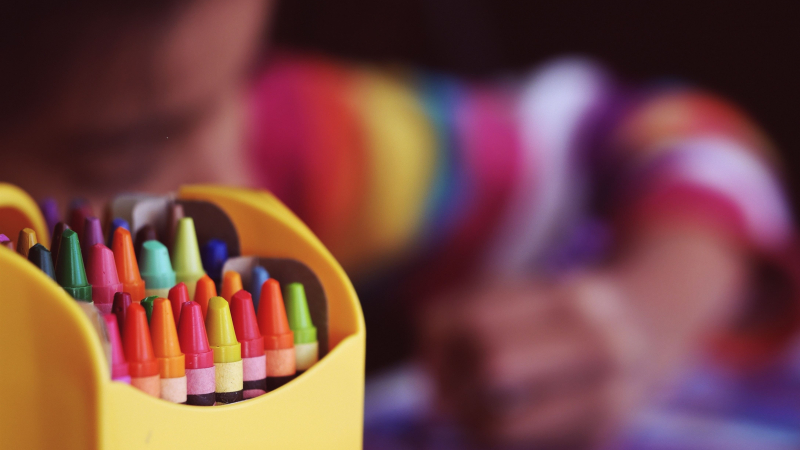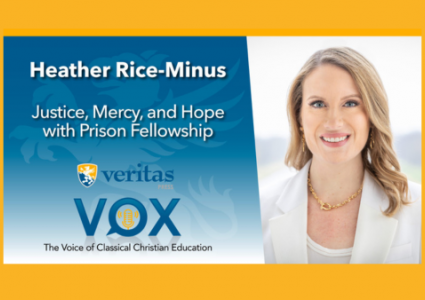The Veritas Approach to Art

K – 12th Grades
Young children are almost without exception “drawn” to art (pun intended)! Their innate curiosity and wonder about the entire creation naturally extends to wanting to capture it in vivid colors on paper. So a formal, comprehensive art program is essential to a classical education from a Christian worldview. Introducing children to the visual arts and training them how to capture beauty addresses the third part of the invaluable trivium of Truth, Goodness, and Beauty.
Done properly, a classical art course uses the God-given way children learn and acquire skills (mostly through imitation), and thereby come to create and appreciate beauty. In keeping with Veritas’ commitment to and use of students’ characteristics at each stage of growth, in our art program we apply the following approach:
GRAMMAR (K - 6th grades):
During the earliest years we use sensory exploration and their natural interest in the world’s variety: colors, smells, light, sounds, textures, even tastes build strong associations in a child’s mind. Wonderful book illustrations can be appreciated very early on. This is a time to guide their exploration of art media, giving them simple objects and scenes to see and copy frequently. Imitation is their God-given way of approaching the adult world. At this level the classical methods we use reinforce and encourage the imitative nature of children.
The primary tool we use, Drawing With Children (by Mona Brooks), presents copying and practice as a means of learning to draw. It insists on developing mastery of basics, focusing on five basic elements—an “alphabet” of shapes:
- dots
- the circle family
- the straight line family
- the angle line family
- the curved line family
Extensive practice is key. Even the great Michelangelo said, “If people knew how hard I worked to get my mastery, it wouldn't seem so wonderful at all.” Unlike some contemporary thought, we recognize great value in the mastery of basics. It’s the “grammar” of art.
Students learn to view the world through these five shapes and how to develop the images on paper. All can learn to become artists to the extent God has gifted them and develop their own unique style of realistic interpretation. And to the extraordinarily gifted, this training in the basics will always serve them well.
As the children mature, we help them attain closer and clearer reproductions in their own work and also increasingly expose them to the names and works of famous masters—learning to recognize similarity (style) of pieces and naming them.
SECONDARY (7th - 12th grades):
Maturing children want to “get it right” in art. They want to present their best in the junior high years, so we introduce and practice more precise techniques. They discover the capabilities of various tools and get many opportunities to practice the right ways to use them. They like knowing the “secrets” of making the tools work well. They learn to apply the basic “elements of art,” e.g., line, shape, texture, balance, etc. in more complex ways than they did when younger. They like being able to produce a certain look, practicing with various objects, differing techniques, and color experimentation. We link recognition of beauty with an appreciation for creation. This is an appropriate time to address clear, biblical principles (e.g., Phil. 4:8) for evaluating art works (old and new), and ask questions related to the meaning and worth of an artistic message, techniques/skills displayed, etc.
| Grade | Live Course | You Teach Course |
|---|---|---|
K-2* | N/A | Art (K-4th) |
3 | Art I - Grammar | Art (K-4th) History of Art |
4 | Art I - Grammar Art II - Grammar | Art (K-4th) Art (5th-6th) History of Art |
5 - 6 | Art II - Grammar | Art (5th-6th) History of Art |
7 - 12 | Art History Art Studio I Art Studio II | N/A |
*History of Art is sometimes taught in second grade by those using the course in conjunction with the history courses.
Simply put, creation is our best model for what God considers beautiful and fitting for imitation and meditation. This doesn’t limit a student’s scope—just the opposite. Creation, including man’s shaping and use of it (as seen in historical events, architecture, landscapes, everyday life), provides us with an almost inexhaustible source of subjects. Principles in God’s Word guide our study of art history, which includes the examination of the best works of artists in the past (most of them non-Christians). We “plunder the Egyptians” and recognize that, self-consciously or not, these artists gave glory to God through beautifully reflecting His light, color, balance, atmosphere, and other true and accurate displays of His character in the work of the creation.
Systematic, encouraging exposure to God-honoring use of creative skills calls to the heart and mind of a child: seeing and appreciating with the heart, understanding and emulating with the mind (eye and hand). Creatively using trained skills to portray a unique vision is the appropriate work of an artist. Glory to God, not oneself, should be the primary goal of all Christian artists. This conviction, combined with skill and the love of real beauty, will set Christian students and artists on a path that will restore great art It will even win over the relativistic, humanistic view of art today.
Learn more about the course options for Art!







